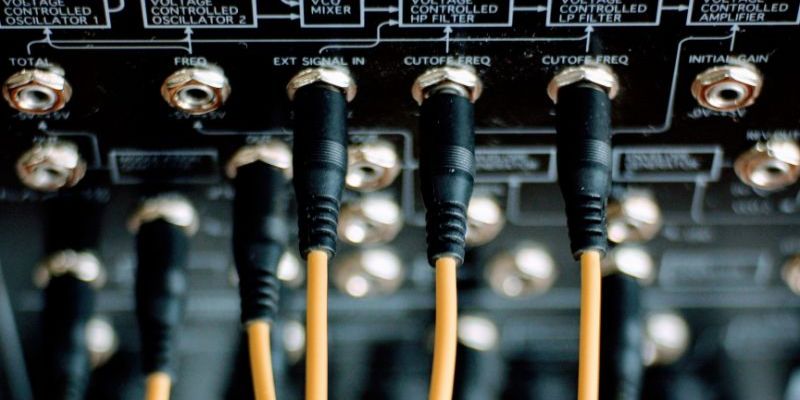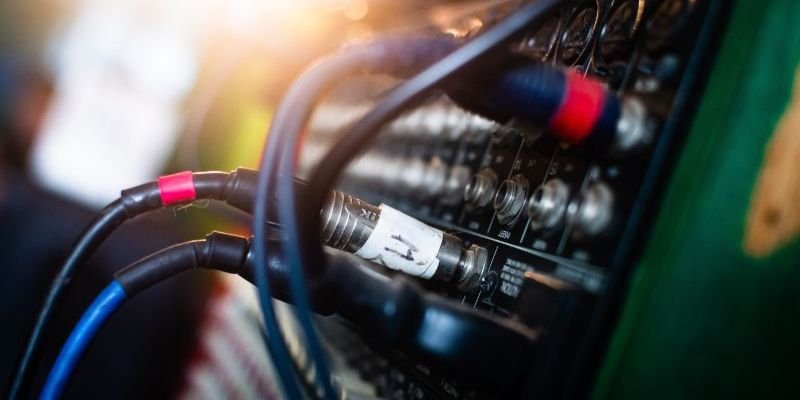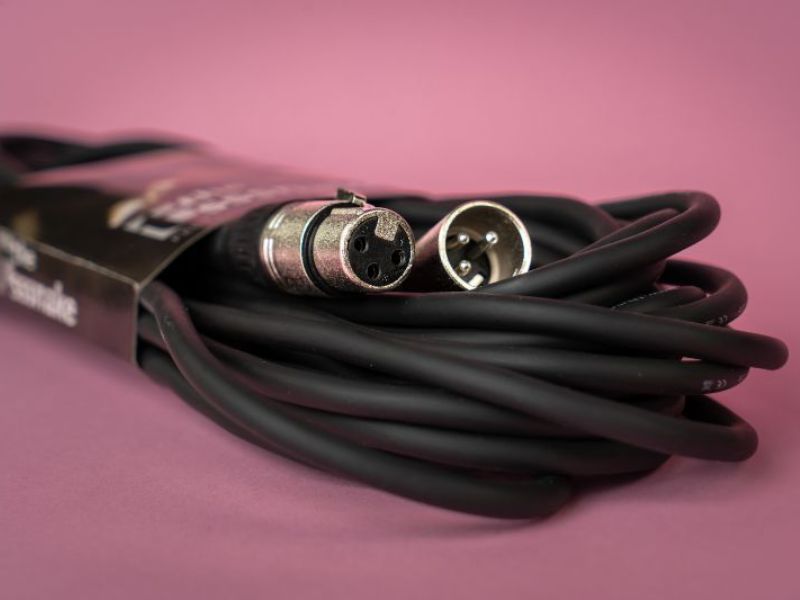Skip to the good bit
ToggleAnalog vs digital signals
When it comes to cables and connectors, we will start right back at the basics. Knowing the difference between analog and digital is step one.
- Analog: Essentially works by transmitting information and energy through electricity. Analog cables will offer continuous waves through the cable. Notably, analog cables are either balanced or unbalanced.
- Digital: Works by transmitting information and energy through binary (1’s and 0’s – all that Matrix stuff!). These cables are at the forefront of technology and continue to adapt and improve yearly.
Balanced vs unbalanced cables
The two types of Analog cables change their performances and output significantly.
What are unbalanced cables?
These cables contain two intertwining wires; the ground wire and the positive polarity (hot) wire. With unbalanced cables, there is a tendency to allow noise to be picked up relatively quickly. Despite this, due to their nature, many musical instruments utilize them to transmit sound. When the cables extend longer than 20 feet, the sound on unbalanced cables starts to wobble.

What are balanced cables?
Balanced cables are preferred by pros and those needing the best quality sound as they are pretty immune to noise interference from the likes of radios or other electronic equipment. This protection from noise susceptibility is due to the extra wire balanced cables boast.
Balanced cables use the ground wire and positive polarity (hot) wire-like in unbalanced cables but also have the negative polarity (cold) wire. The hard wire here is key to noise cancellation and allowing this cable type to be the most effective, high-fidelity audio.
When the audio goes into the balanced cables, both the (-) and the (+) wires receive the same signal, but unlike with unbalanced cables, the present (-) cable is inverted. As the audio travels to the end of the cable, the positive wire carries on like an unbalanced cable, but the negative wire is flipped in polarity to match the positive wire polarity audio and ‘balance’ the sound.
The (-) and (+) wires cancel each other out by the time the sound reaches the end of the wire and means you get a pure sound free from obstruction – a sweet spot if you will.
Types of cables and connectors
When it comes to types of audio cables, many often wrongly identify them through their more specific class rather than firstly splitting them into analog and digital-first off – let me tell you, we are not going to make such a rookie error. Instead, we have divided the common types of cables below into analog and digital for your convenience.
Analog cables and connectors
TS and TRS connectors
The ¼ inch connector or jack, as they are more famously known, are found on all sorts of musical equipment and provide a classic sound. TS (Tip Sleeve) connectors are generally used for unbalanced audio signals, whereas the TRS (tip ring sleeve) connectors provide a smoothly balanced sound. TRS’s usually have an extra ring around the base of the head, which allows for balancing and is easy to spot.
TS connectors are usually used for more malleable sounds, like from your guitar to your amp and known as ‘Instrument cables’. The TRS connectors connect your audio interfaces with your mixing equipment, desks and PA equipment for sharp, crisp audio.
The difference in these connectors themselves is just purely a balance issue, but it makes a difference in audio quality and sound interference. The tiny black wire on the head of the cables can change the audio.
- Benefits of TS and TRS connectors – Universally used cables.
- Disadvantages of TS and TRS connectors – Often falter in terms of sound interference.

Stereo mini jack connector
Jack connectors are without a doubt the most famous of all audio connectors. It is the one you will find on headphones and most handheld media inputs and outputs. The stereo mini-jack is a TRS type connector, but it is shrunk in size, down to 1/8 inch.
They provide a balanced sound and are versatile, allowing use between headphones and phones, handheld devices and car radios or plugging devices into speakers.
- Benefits of the jack connector – Versatility and integral to the famous quote – “pass me the AUX”.
- Disadvantages of the jack connector – Sub-standard sound quality
RCA connector
The RCA connector is a cable capable of transmitting visual and audio signals. They also allow for both analog and digital audio sound transmittance, meaning this style of cable is superbly versatile.
When transferring analog sound, an RCA cable will transfer unbalanced audio sound. You will need both RCA cables to transmit stereo information sound. When using RCA cables digitally, you can allow the stereo transfer and surround sound information. RCA cables tend to have male connectors, which are color-coded red and yellow, inserted into female connecting points on your devices.
TVs, DVD players, speakers and record players have historically used RCA connectors for sound. Indeed, if you are still spinning vinyl, you may need to hook up an RCA cable to get things moving.
- Benefits of the RCA connector – Transmit both unbalanced and balanced audio whilst transmitting sound and visual signals.
- Disadvantages of the RCA connector – Out-dated
The XLR connector
This type of cable is standard for balanced audio and can offer cables with up to 10 pins but usually have three pins. They singularly allow the user to transmit a proportional mono signal, so more cables are required to transmit a stereo analog signal.

These connectors block out any feedback and make them the perfect wire for microphone use. The cables tend to have a secure connection which prevents any noise obstructions. It also makes them very durable.
- Benefits of the XLR connector – Secure and durable
- Disadvantages of the XLR connector – Pins often get dirty and interfere with sound
Digital cables
Interface cables – USB, FireWire, Thunderbolt
USB connections are pretty standard across the board for transferring data digitally. When it comes to audio, they are the slowest of the three interface cables to do their job. Despite this, USBs will work well in home studio environments. FireWire cables were the best cables going in the early 2010s. These cables offered unprecedented data transfer and were much superior in speed to USBs.
However, since the introduction of the Thunderbolt cables, there is not a great deal of competition. These cables are faster, more adaptable and better than both the USB 3.1 and FireWire 800 cables who top their respective connectors.
- Benefits of interface cables – Versatile compatibility
- Disadvantages of interface cables – They can be limited in audio quality and range
MIDI cables (Musical Instrument Digital Interface)
Electronic musicians typically use these cables. They are ideal for connecting multiple instruments, computers and audio devices at once. These cables can carry information such as tone, pitch and tempo – hugely beneficial for those recording tunes.
These cables are excellent for connecting keyboards and synths to your computer. These effective cables allow the audio to transfer crisply and accurately. MIDI cables also work back the way from the computer to the instrument if need be.
- Benefits of MIDI cables – Carry a range of different signals from tempo to pitch
- Disadvantages of MIDI cables – Limited to a niche musical area
Optical cables
These types of cables are great for broadband and telecommunications over long distances. They work by transmitting a signal via a series of light pulses, and they are super effective at this.
They can quickly transfer multiple audio options all in one cable and accepted across two signals. You can get an excellent all-in-one cable for audio transfer. Meaning you get to cut back on cables in the studio. These are the future when it comes to audio.
- Benefits of optical cables – Rapid and effective
- Disadvantages of optical cables – Not specific to musical cables and costly
Which cable is best for me?
Identifying which cable is best for you does depend on what you are planning on doing. Each cable is relatively specific with the sound, equipment and style of output that it combines with. Knowing which devices you plan to use before choosing which cable you are going to opt for. Increasingly, manufacturers are producing different types of wireless speakers, but this does not mean cables aren’t helpful anymore – they are here to stay. You might not be an expert yet, but after reading this, you are well on your way!









